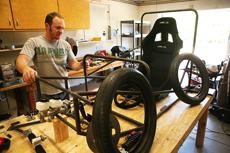A group of UA students hope sunny days are ahead for them and their new solar powered car.
The Arizona Solar Racing Team plans to enter a car, the first of its kind, in the 2009 Shell Eco-marathon Americas on April 15 in Fontana, Calif.
Plans for the new car began in
September. Unlike the previous racecars the team has built, this one will have four wheels and regular car doors, but it will only be 50 inches tall, said chief engineer Oliver Stickroth, a material sciences and engineering senior.
This car is for a different type of competition, he said. Previously, the race team has designed several different long-distance solar cars starting in 1999 when the club was formed. Those cars looked more like space ships than cars, with only three wheels, a hatch for the driver to sit in instead of front seats, and the entire top was covered in solar panels.
This new car will look like an actual car, Stickroth said. The biggest difference though, will be the solar panels. Instead of just being stuck to the top, the solar panels will rotate to follow the sun.
This is incredibly important if they want their design to be practical for any type of solar car that could be sold in the future, he said. The sun is not always directly overhead and to be efficient, the panels need the most direct sunlight they can receive.
This is the first time an active tracking solar array has been put onto a solar-powered car.
“”It hadn’t been energetically feasible before. It takes power to move the array. We’re making it feasible,”” said
design leader Collin Mechler, a material sciences and engineering senior.
The team receives no funding from the UA, just use of facilities, Stickroth said. Sponsors such as the Arizona Research Institute for Solar Technology, Boeing and Raytheon have provided funding for the program.
The total cost of the car will be around $75,000, Stickroth said. He said the most expensive parts are the solar arrays and the lithium batteries that are needed. The more efficient the solar panels are, the more expensive they are.
They were also able to cut construction costs by making deals with companies for discounts on parts in exchange for placing a sticker on the car.
The other parts though, Mechler said, are mostly off the shelf car parts. They have tried to use as few custom parts as possible.
“”The cars aren’t fast, they’re a max of 350 lbs. They’re judged on efficiency,”” Stickroth said.
The cars will only go 25 mph in the race, but Stickroth said they are hoping to put a bigger motor into the car so it will be able to get up 85 mph.
Members of the group would also like to make the car street legal so they can drive to Washington D.C. where a Solar Decathlon is being held, in which the College of Architecture is entering a solar house, Mechler said.
The cars are measured on their miles per joule, Stickroth said. For the Shell Eco-marathon, UA is the only school submitting a solar powered car in the urban concepts class. The other cars are diesel and are also being judged on efficiency.
“”We’re moving in the direction of making a car that people would want to drive on a daily basis,”” Mechler said. “”What we’re aiming to do, by creating a moveable array, is to create something people would want to drive to the grocery store.””
He said their previous cars were a good first step.
UA’s team is made up entirely of students. There are about 20 students consistently working on the car and all of them are engineering students, Stickroth said.
“”We all work very well together,”” Mechler said.
Everyone has different engineering backgrounds, they all specialize in different areas of the car, he said.
“”Most of the other schools have faculty working directly on the cars, but we don’t,”” Stickroth said.
“”We’re trying to use everything to its maximum efficiency,””









